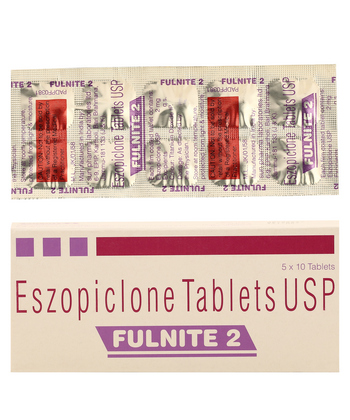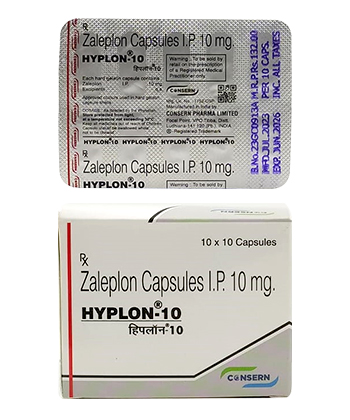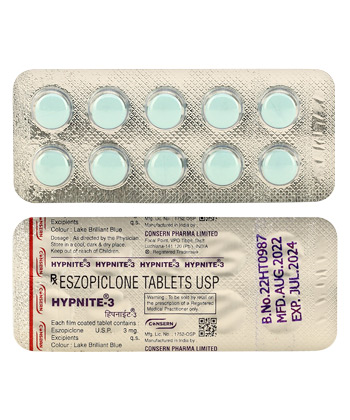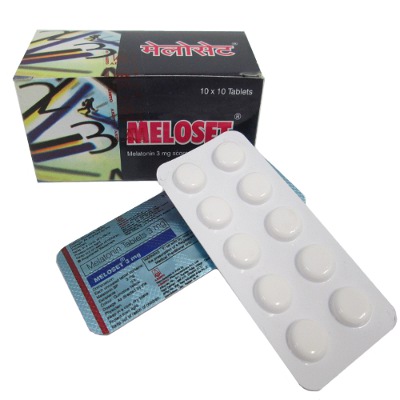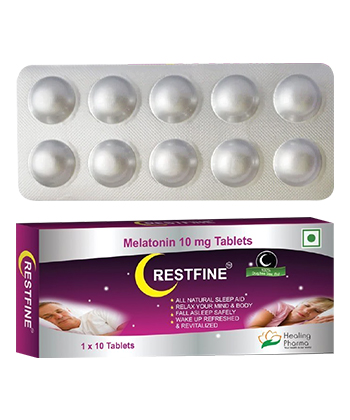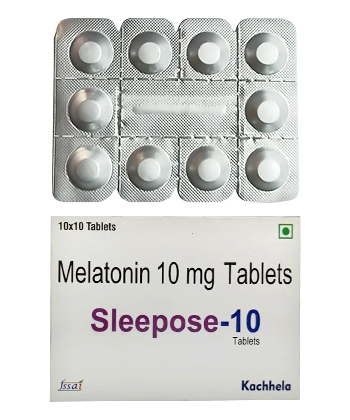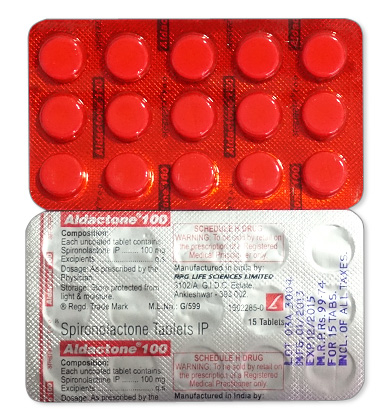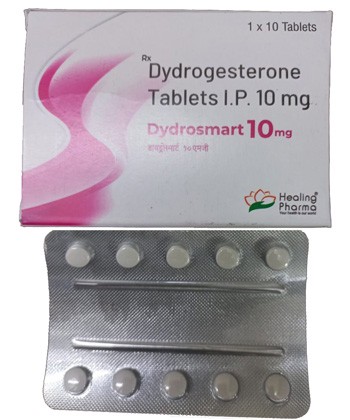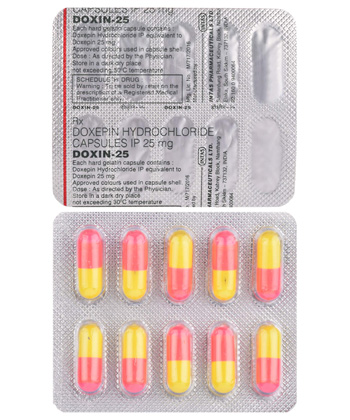
Doxepin
- In our pharmacy, you can buy Doxepin without a prescription, with delivery options available throughout the US.
- Doxepin is used to treat depression and anxiety disorders. It functions as a tricyclic antidepressant, affecting neurotransmitters in the brain.
- The usual dose of Doxepin is 25–100 mg, depending on the condition being treated.
- The form of administration is a capsule or tablet.
- The effect of the medication typically begins within 1–2 hours.
- The duration of action is approximately 24 hours.
- Alcohol may increase side effects; it is advisable to avoid alcohol while taking this medication.
- The most common side effect is drowsiness or sedation.
- Would you like to try Doxepin without a prescription?
Basic Info
| Information | Details |
|---|---|
| INN (International Nonproprietary Name) | Doxepin |
| Brand Names in Canada | Doxepin HCl, Silenor, others |
| ATC Code | N05AH03 |
| Dosage Forms Available |
|
| Manufacturers | Canada: EGIS Pharmaceuticals, others |
| Registration Status | Approved by Health Canada |
| Classification | Prescription-only (Rx) |
Doxepin is an important medication primarily used for conditions like depression, anxiety, and insomnia. Being aware of its proper utilization is essential for patients seeking effective treatment. It is offered under several brand names in Canada, such as Doxepin HCl and Silenor, and is categorized as a prescription medication.
This medication falls under the ATC classification code N05AH03. It’s crucial to know that Doxepin comes in several dosage forms, including capsules, tablets, and oral solutions. The various strengths available provide flexibility in prescription, addressing the unique needs of patients.
Healthcare providers prescribe Doxepin after evaluating patients’ medical history and performances in managing symptoms. In Canada, it’s manufactured by companies like EGIS Pharmaceuticals, ensuring quality and compliance with local regulations. As it’s classified as a prescription-only medication, it is imperative that individuals discuss its usage and effects with their healthcare professionals to maintain safety and health.
Pharmacology
Understanding the pharmacological aspects of Doxepin can empower users.
The drug primarily functions as a serotonin and norepinephrine reuptake inhibitor, effectively regulating mood and sleep patterns. In simpler terms, Doxepin helps balance chemicals in the brain, promoting overall emotional stability. Its antihistaminic properties additionally aid in managing various allergic reactions.
In terms of pharmacokinetics, Doxepin exhibits rapid onset with effects typically noticeable within one to two hours, especially when used for sleep-related issues. After oral administration, it is metabolized by the liver via the cytochrome P450 enzyme system, where a significant first-pass effect occurs. The elimination half-life of Doxepin ranges from 15 to 25 hours, which is essential for understanding how long its effects may last in the body.
Patients should be aware of potential drug interactions, particularly with MAO inhibitors and other central nervous system depressants. It's advisable to avoid high-fat meals, as they may increase the drug's absorption, and caution should be exercised with alcohol, as it may enhance sedation.
Indications
Doxepin is prescribed for several conditions, primarily aiming to treat major depressive disorder, manage anxiety disorders, and address insomnia under the brand name Silenor. Its widespread use indicates its importance in various therapeutic settings.
Off-label, Doxepin may also assist patients with chronic pain syndromes and conditions like fibromyalgia, showcasing its versatility in treating complex cases. However, while it offers broad applications, healthcare providers should carefully consider individual patient circumstances when recommending it.
Special populations, including children and the elderly, may require tailored approaches. Doxepin is not approved for individuals under 18 experiencing anxiety or depression. For elderly patients, starting with a lower dose is recommended due to their increased sensitivity and the potential for side effects. Pregnant individuals should only use Doxepin if clearly required, given the limited data regarding safety during pregnancy.
Dosage & Administration
When it comes to dosing Doxepin, precision is key.
Typical dosages vary by condition:
| Condition | Adult Dosage | Pediatric Dosage |
|---|---|---|
| Depression | 25-150mg daily | Not typically used |
| Anxiety | 10-75mg daily | Not typically used |
| Insomnia (Silenor) | 3-6mg taken at bedtime | Not approved |
Adjustment of dosing is particularly important for individuals with renal impairments and elderly patients, necessitating thorough assessment of their condition.
Monitoring treatment duration is vital, as conducting periodic evaluations ensures ongoing effectiveness and safety. Avoiding abrupt cessation is crucial to prevent withdrawal symptoms or a return of symptoms.
Proper storage of Doxepin requires it be kept at room temperature, shielded from excessive moisture and heat, to maintain its effectiveness and integrity.
Safety & Warnings
While Doxepin is beneficial, certain safety measures must be exercised.
Absolute contraindications include hypersensitivity to Doxepin. Relative contraindications involve a history of bipolar disorder or conditions such as urinary retention and narrow-angle glaucoma, underscoring the importance of thorough patient evaluations.
Common side effects experienced include drowsiness, dry mouth, and constipation. Some patients may face rare side effects like confusion, hallucinations, or cardiovascular issues, so maintaining open communication with a healthcare provider is essential.
Caution is advised when prescribing Doxepin to individuals with liver or kidney impairments due to the potential for increased side effects. Pregnancy is categorized under category B, indicating limited safety studies.
The black box warning highlights a critical concern regarding an increased risk of suicidal thoughts and actions in children and young adults, necessitating vigilance from healthcare providers and caregivers alike.
Patient Experience
When considering Doxepin, many patients have questions and concerns about its effectiveness and side effects. User reviews from platforms such as Drugs.com and WebMD provide valuable insights.
Feedback generally highlights:
- High effectiveness: Many users report significant improvements in sleep and anxiety symptoms.
- Side effects: Morning drowsiness and weight gain are frequently mentioned as notable drawbacks.
Discussion forums on sites like Reddit and Facebook reveal even more personal experiences. Many users have expressed challenges with discontinuing Doxepin, indicating that this medication may lead to dependency for some individuals.
Overall, satisfaction with Doxepin is quite significant. However, mixed feelings regarding dependency worries and affordability do emerge among users. Conversations reflect a blend of positive outcomes with underlying concerns, making it essential for patients to weigh both sides when considering this medication.
Alternatives & Comparison
Not all patients may find Doxepin to be the best fit for their treatment. In Canada, several alternatives are available:
| Name | Price | Efficacy | Availability |
|---|---|---|---|
| Amitriptyline | Approximately $30 | Similar efficacy for depression | Available at local pharmacies |
| Mirtazapine | Approximately $40 | Effective for sleep as well as mood | Available at local pharmacies |
Local physicians often recommend these alternatives based on patient experiences and individual side effect profiles. Consideration of these factors can lead patients to make informed choices about their treatment options.
Market Overview
Doxepin is widely available at major Canadian pharmacies, including Catena and HelpNet. Prices typically range between $25 and $60, depending on the dosage and formulation.
Patients will find Doxepin packaged in various forms:
- Blister packs
- Bottles
- Oral solutions
Interestingly, demand for Doxepin tends to increase during the winter months. This rise is often attributed to the need for insomnia and anxiety management associated with Seasonal Affective Disorder (SAD), making awareness of market trends crucial for potential users.
Research & Trends
Recent studies conducted between 2022 and 2025 are beginning to uncover broader applications for Doxepin. Meta-analyses highlight its effectiveness in treating chronic pain conditions alongside anxiety issues, indicating a promising dual-use potential.
Moreover, ongoing research is delving into experimental uses of Doxepin, particularly its benefits for conditions like PTSD and other anxiety-related disorders.
Affordability and access are also enhanced by the availability of Doxepin in its generic form. The expiration of its initial patent has expanded options for patients, encouraging more brands to offer alternative solutions at potentially lower prices.
Doxepin FAQ
Many people have straightforward questions about Doxepin. Here’s a rundown of common inquiries to make navigating your treatment easier.
How should I take Doxepin?
It's crucial to take Doxepin exactly as prescribed. Generally, it is recommended to take it at bedtime, especially for treating sleep disorders. This timing helps maximize the medication's effectiveness while minimizing daytime drowsiness.
Can I drink alcohol while taking Doxepin?
Alcohol and Doxepin do not mix well. Consuming alcohol can enhance the drug’s sedative effects, increasing the risk of excessive drowsiness and impaired judgment.
What if I miss a dose?
If you happen to miss a dose, take it as soon as you remember. However, if you're nearing the time for your next dose, it's safer to skip the missed one. Doubling up is not advisable.
Is Doxepin safe during pregnancy?
Pregnant individuals should use Doxepin only if it is clearly necessary. Consulting with a healthcare provider is the best course of action to weigh potential risks and benefits.
Are there any serious side effects?
There are notable side effects to be aware of, such as severe allergic reactions and increased thoughts of self-harm. If these occur, seek immediate medical attention.
Can Doxepin be used in children?
Currently, Doxepin is not recommended for those under eighteen who are being treated for depression or anxiety, highlighting the need for caution in younger patients.
How much does Doxepin cost?
The cost of Doxepin generally ranges from twenty-five to sixty dollars, varying based on dosage and the pharmacy you choose. Checking different pharmacies can help you find the best price.
Guidelines for Proper Use of Doxepin
Being clear about how to properly use Doxepin can enhance treatment success and safety. Here’s what you need to know.
When and How to Take:
Doxepin should ideally be taken at bedtime and is best absorbed when taken with food. This approach can help you get the most out of the medication.
What to Avoid:
Steer clear of alcohol and other CNS depressants while on Doxepin, as these substances can enhance drowsiness and can lead to unsafe situations.
Storage Recommendations:
Keep Doxepin stored in a cool, dry place, away from excess heat and humidity. Proper storage is vital for maintaining the medication’s effectiveness.
Common Mistakes:
- Avoid stopping the medication abruptly without consulting a physician.
- Never adjust your dosages without professional advice, as this can lead to complications.
Read the Patient Leaflet:
Always take the time to read the information leaflet provided with your medication. It contains additional instructions and crucial advice for safe usage.

